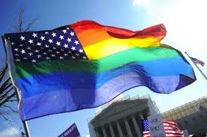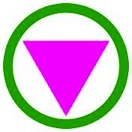Students will:
- identify and analyze symbols that have played an important part in fighting for equal rights for LGBT people.
- define a relationship between art and activism.
- describe elements of art or symbols that encourage awareness and change.
- How can an artist or designer be a leader? How can an artist or designer not be a leader?
- How do symbols acquire meaning?
- In what ways do activist movements rely on art and artists?
This lesson is part of the series Art and Activism.
Overview
Children see symbols around them every day, often without explicitly understanding either the history or the meaning behind these symbols. This lesson will view symbols as a type of art and will focus explicitly on the way symbols have been used to advance LGBT visibility and awareness of fights for LGBT rights. The pink triangle and rainbow are only two of many symbols used in different activist movements, but the lessons they teach about how much can be communicated through a picture are really important for kids—and particularly preliterate kids—to understand. Seeing that a picture can not only tell a story but also communicate a message and a belief is one way of empowering children to use their own art and design to fight for what they believe in.
Activities
Give students a chance to talk about these images and discuss any thoughts or questions that they have. Some children’s books that might help with your discussion include The Family Book by Todd Parr, The Different Dragon by Jennifer Bryan, In Our Mothers’ House by Patricia Polacco and The Adventures of Tulip, Birthday Wish Fairy by S. Bear Bergman.
- Ask students if they know what a symbol is. Explain that a symbol can be anything that stands for something other than what it is, and often it is a concrete object that stands for something larger or more abstract. If your school has a symbol, mascot or logo, you can use this as an example to explain more concretely what a symbol is. Explain that they frequently see symbols on bathrooms—images of men or women that may or may not look realistic, but stand for who is meant to use a particular bathroom. Invite students to offer other examples of symbols that are familiar to them. Chart the examples that they share, and invite them to your chart to draw their own sketches if they wish.
- Explain that throughout history, various groups have used symbols as a way of showing their wish to be treated fairly. These symbols are often used as artwork or in artistic ways. Two good examples come from LGBT rights movements: the pink triangle and the rainbow flag. Show students images of these two symbols:


Students may or may not be familiar with these symbols. Give them a brief background by explaining that the pink triangle was used to label homosexuals at a time when they were meant to be separated and treated very differently. (Note: Older students, or those familiar with the Holocaust, might know more about this time period and be ready for a more detailed history, but the main point of this lesson is around the symbol, rather than the history of oppression.) Since that time, LGBT people have come to use the triangle to show their pride in their identity and make themselves visible. The rainbow flag was designed by a California artist in the 1970s, and the colors are meant to symbolize the diversity of the LGBT movement and the importance of freedom. Ask students whether they have ever seen these symbols and if so where and what they made them think about.
- Give the students a variety of examples of the pink triangle and rainbow used in and as art.


Extension Activity
This lesson introduced children to the idea of symbols as art. They will likely be more alert to the symbols they see in the world around them. Ask students to keep track of artistic symbols that they see being used to promote activism, whether about LGBT rights or other issues. Remind them that often these symbols are in unexpected places: on buttons, T-shirts, flags, even drawn onto the sides of buildings. Ask that your students view them with the eyes of artists as well as activists and come back to class ready to share examples of what they have noticed.
